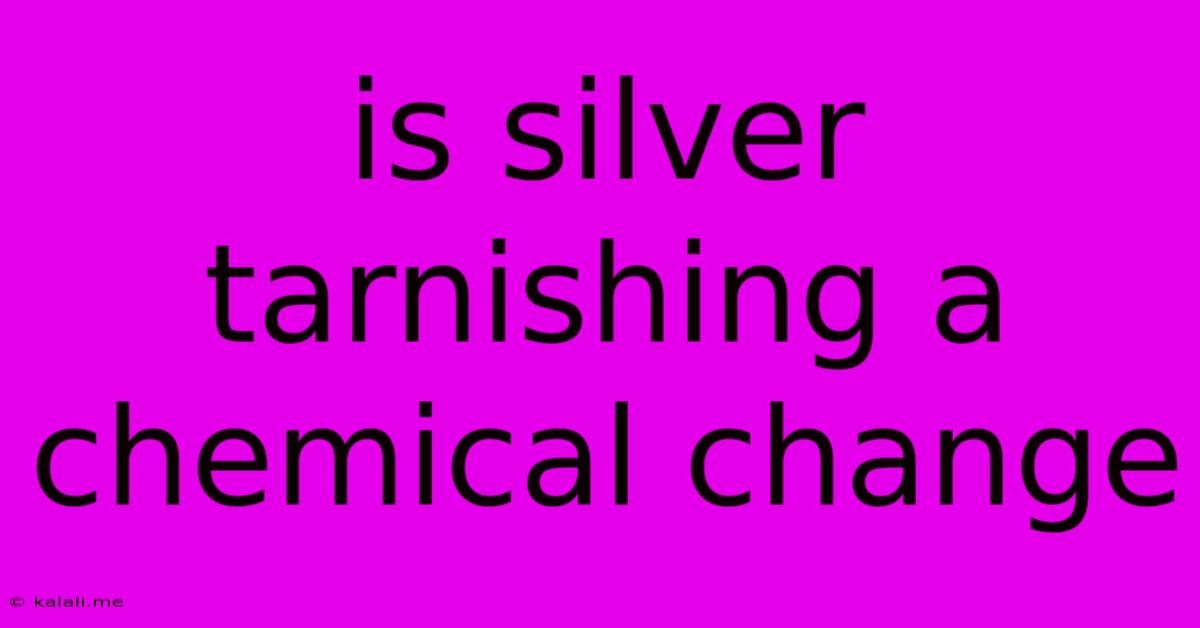Is Silver Tarnishing A Chemical Change
Kalali
May 10, 2025 · 3 min read

Table of Contents
Is Silver Tarnishing a Chemical Change? A Deep Dive into Oxidation
Silver tarnishing, that dull film that appears on silverware over time, is a common observation. But is it a physical change or a chemical change? The answer, unequivocally, is chemical. This article delves into the science behind silver tarnishing, explaining why it's classified as a chemical change and exploring the factors that contribute to this process.
Understanding Chemical vs. Physical Changes:
Before we dissect silver tarnishing, let's clarify the fundamental difference between physical and chemical changes. A physical change alters the form or appearance of a substance without changing its chemical composition. Think of cutting paper – you change its shape, but it remains paper. A chemical change, on the other hand, results in the formation of a new substance with different chemical properties. Burning wood is a classic example – you end up with ashes and smoke, completely different substances from the original wood.
The Chemistry of Tarnished Silver:
Silver tarnishing is a chemical reaction known as oxidation. It occurs when silver (Ag), a highly reactive metal, reacts with sulfur-containing compounds in the air, such as hydrogen sulfide (H₂S). Hydrogen sulfide is prevalent in the environment, often originating from volcanic activity, industrial emissions, and even the breakdown of organic matter.
The reaction can be simplified as follows:
4Ag(s) + 2H₂S(g) + O₂(g) → 2Ag₂S(s) + 2H₂O(l)
This equation shows silver (Ag) reacting with hydrogen sulfide (H₂S) and oxygen (O₂) to produce silver sulfide (Ag₂S), the black tarnish, and water (H₂O). The crucial point here is the formation of a new substance, silver sulfide, which possesses different properties than elemental silver. This is the hallmark of a chemical change.
Factors Affecting Silver Tarnishing:
Several factors influence the rate of silver tarnishing:
- Exposure to air: Greater exposure to air, and consequently, to sulfur-containing compounds, accelerates tarnishing.
- Humidity: High humidity provides a more favorable environment for the chemical reaction to occur.
- Presence of pollutants: Areas with higher levels of air pollution containing sulfur compounds will cause faster tarnishing.
- Temperature: Higher temperatures generally increase the rate of chemical reactions, including silver tarnishing.
Is it Reversible?
While silver tarnishing is a chemical change, it's often reversible. The silver sulfide layer can be removed through various cleaning methods, restoring the silver's original shine. These cleaning methods essentially reverse the chemical reaction, although this is typically a chemical process in itself, often involving reactions with other chemicals. This doesn't change the fact that tarnishing itself was a chemical reaction.
In Conclusion:
Silver tarnishing is undoubtedly a chemical change. The formation of silver sulfide, a new substance with different properties than elemental silver, is clear evidence of a chemical reaction. Understanding this process allows for better prevention and cleaning techniques to preserve the luster of silver objects. The rate of tarnishing can be influenced by several environmental factors, highlighting the importance of proper storage and care of silverware and other silver items.
Latest Posts
Latest Posts
-
What Is Considered Tall For A Man
Jul 14, 2025
-
Which One Of These Lines Uses Iambic Pentameter
Jul 14, 2025
-
How Do You Spell To In French
Jul 14, 2025
-
Did Faith Hill Have An Affair With Alan Jackson
Jul 14, 2025
-
What Is The Surface Area Of The Cube Below
Jul 14, 2025
Related Post
Thank you for visiting our website which covers about Is Silver Tarnishing A Chemical Change . We hope the information provided has been useful to you. Feel free to contact us if you have any questions or need further assistance. See you next time and don't miss to bookmark.